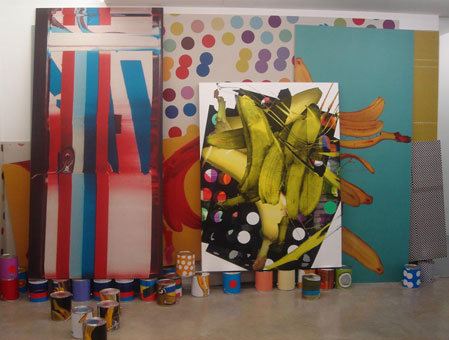Guyton\Walker
dal 24/6/2009 al 24/7/2009
Segnalato da
24/6/2009
Guyton\Walker
Air de Paris, Paris
"Guyton\Walker's works look almost like advertisements for themselves. This is because, usually, after the container of the raw materials (the can of paint), the construction material becomes not only a format but also, more accurately, the support it has always been for the construction of the walls of our white cube. Which is not the case here, where the walls are covered, then fill the cube."

It's a question that crops up often: how does the toothpaste tube come to contain red stripes? We don't have an answer, but the tube must somehow be designed so that the paste always comes out striped. After all, chronologically, it dates back further than the modern bathroom; and it's an advertising entity that's been reproduced, multiplied and put on posters and signboards everywhere.
The same goes for the work of Guyton\Walker, which consists of prints (silkscreens, digital prints) on large-format supports from canvas stretchers to sheets of plasterboard. As critic Vincent Pécoil has said of Wade Guyton, "picture" is more appropriate than "painting". These pictures are placed on cans of paint covered with prints which, you guess, are like the pictures. So the can of paint becomes a support in the sense of being a picture, and the picture in turn is the support for the paint. And what's more the cans of paint accumulate and in turn fill up the exhibition spaces.
The same is true of these Guyton\Walker works as of our tube of toothpaste and its media treatment, but without the time distances between each of the operations: the cans of paint are supposed to contain not just paint but also the images printed on them.
However the images have been created via a number of operations requiring tools (scanner, Photoshop, photocopier, digital printer, etc.) and functions (outlining, overlaying, displacement, etc.). The original, scanned material is as identifiable as it is varied: fruit (kiwis, bananas, coconuts, apples, pears, etc.) and reproductions of other works (a Fischli & Weiss sculpture) or advertisements (for Danish furniture, a Swiss airline, etc.). We can imagine how these images have been produced, but we don't know how they came to be contained in the pots or how they made their way onto the various supports (canvas, paraffin and, more recently, drywall). There's so much reproduction, multiplication and signboarding going on that Guyton\Walker's works look almost like advertisements for themselves. This is because, usually, after the container of the raw materials (the can of paint), the construction material becomes not only a format but also, more accurately, the support it has always been for the construction of the walls of our white cube. Which is not the case here, where the walls are covered, then fill the cube.
Guyton\Walker is not Wade Guyton added to Kelley Walker, but a third artistic, creative identity signalled by the reverse slash between the two names. Neither + nor /, then. In 2004 Wade Guyton, invited to show at Midway Contemporary Art in St Paul/Minneapolis, extended the invitation to include his longtime acquaintance Kelley Walker, with whom he had shared a studio. Since the resultant exhibition, "XXXXX BBB XXXXXFFFFFF FFFF", Guyton\Walker has always claimed to be a creator of "objects", although not without making frantic play with the references and clichés of the art of the last forty years: Pop, Formalism, Appropriationism, reproduction techniques, the status of the image and the issues of the support, the picture, the format, collaboration between artists and, ultimately, painting itself. The strength of their works has as much to do with their formal power as with an unconcealed heritage of printing and image-manipulation techniques and of the use of large formats in American art, from Rauschenberg to Warhol to Guyton and Walker separately. And yet all suggestion of nostalgia is swept aside – see their conversation with Douglas Fogle and John Rasmussen in The Failever of Judgement (pub. JRP/Ringier), the catalogue of their first exhibition – just as the idea of consumption is suggested in terms not of the consumer society, but of digestion as a means of generating energy: "Eventually the fruit needs to be eaten and essentially destroyed to become useful"(1). Electric in this instance, this energy is also communicated by fruit – coconuts – in the form of imposing chandeliers. The same energy is transmitted by their generous, proliferating exhibitions, and the catalogue's listing of the materials for their MAMbo exhibition reads like a recipe: "20 stretchers of three different sizes, 2000 paint cans, 12 quintals of paint", etc. etc.(2)
So rather than the toothpaste model – which could give rise to confusion with Kelley Walker's use of toothpaste in combination with his scanner – we should maybe be looking at the recipe model: a set of operations using a number of basic ingredients. And in the final analysis we don't really know, either, how these ingredients end up as dishes on the table – the ingredients being, here, paint, paint cans, stretchers, plaster sheet, images and motifs, together with the recipe and its own media treatment.
Vincent Romagny, may 2009
Trad. John Tittensor
1 Fabrice Stroun (ed.), Guyton\Walker: The Failever of Judgement, Zurich, JRP/Ringier, 2005, p. 54.
2 MAMbo: Muséo d'Arte Moderna di Bologna, p.57.
Opening reception Thursday June 25th 4-9 pm
Air de Paris
32 rue Louise Weiss - Paris
Free admission



